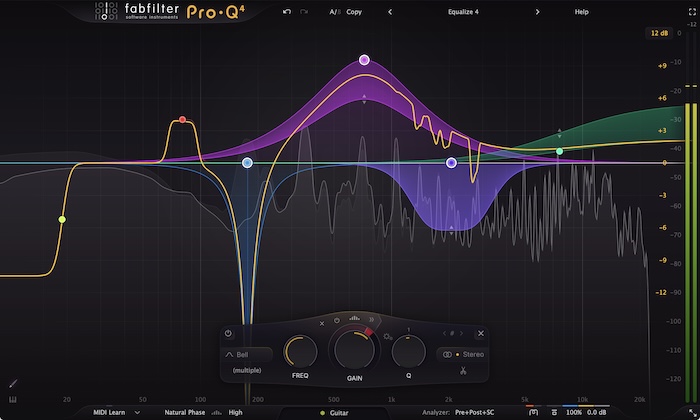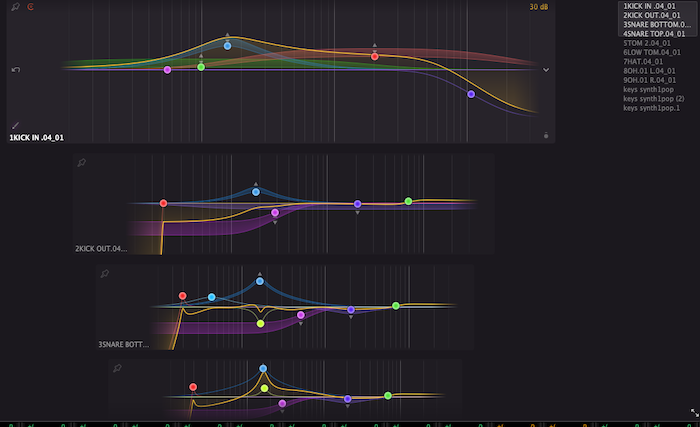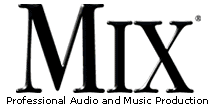 |
|
Fab Filter Pro-Q 4 Main Screen |
FabFilter, based out of Amsterdam, the Netherlands, has
released its latest version of the popular Pro-Q plug-in
equalizer. Pro-Q 4 has several new features that add to
the noteworthy transparent processing of its predecessor, Pro-Q 3,
which was released in 2018. These upgrades necessitated a complete
redesign to make it the company's ultimate, mastering-grade
mixing/tracking equalizer.
Users of Pro-Q 3 will know that there are up to 24 bands of
EQ with selectable filter types and 6 dB to 96 dB/octave slopes
including a steep, "brick wall" slope for the high and low-cut
sections. For the most precision mastering processing, you may
choose fractional slope settings such as 3.3 dB/octave for the LP or
HP filter.
An All-Pass filter has been added for correcting phase anomalies,
and you can copy-and-paste EQ settings between two or more
instances and directly enter settings in the EQ window. Any
individual EQ instance can be set to Zero Latency, Natural Phase or
the newly improved Linear Phase EQ (with its attendant latency).
There is support for Dolby Atmos 9.1.6, surround channel linking,
and per-band, Stereo, Left, Right, Mid or Side modes.
Pro-Q 4 will co-exist with all previous versions of Pro-Q you
may have, and FabFilter has re-created and ported its stock Q3
presets over to Q4 versions. The company says Pro-Q 4 will read all
previous versions' presets as long as you use their preset structure
and not your DAW's.
Available for Mac and Windows, Pro-Q 4 comes in VST, VST3,
AU, AAX Native, AudioSuite and Clap formats. For Mac, it's OS 10.13
or higher for 64-bit, while PCs require Windows 11, 10, 8, 7 or Vista
and a VST 2 or 3 host.
Spectral Dynamics
A significant change is Spectral Dynamics, which builds on Pro-Q
3's dynamic EQ; it's available on any EQ band within an instance.
Spectral Dynamic EQ will apply threshold-based expansion or
compression on a specific EQ band without affecting the rest of
the audio running through the plug-in. Essentially, you're "tuning
in" a section of sound on a track you'd like to manipulate--such
as dynamically compressing down peaky resonances or expanding
upward only the high frequencies of a dark-sounding instrument.
This is a wholly new approach and technique for equalization.
Updates here also include:
adjustable attack and release
times with the given default
values a good starting point, and
now there is side-chain access.
Mousing over a control always
reveals a helpful "pop-up"
window to explain what that
particular control does.
I Love it!
 |
|
Fab Filter Pro-Q 4 Instance List |
Instance List
Clicking on the track name at
the bottom of the GUI launches
the Instance List over the main
window. Instance List is a
brilliant and modern idea when
mixing music--especially on
large sessions with numerous
tracks. It harkens back to the
days of mixing on an analog
console where all the equalizers
Fab Filter Pro-Q 4's main screen. were visible in the channel strips in front of you. You can see all the EQ curves
you've set up and cycle through them to dial in
any individual EQ while the mix is playing.
The resizable GUI shows all the individual
Pro-Q 4 plug-in instances running at the same
time and in one window. You'll see the spectrum
displays and nodes, along with the same editing
facilities, only in an expandable, smaller view.
The right-hand sidebar shows groups of Pro-Q
4 plug-ins, ready to click on and move to the
center of the window for close scrutiny.
Instances come up in a scrollable stack
arranged alphabetically, not sequentially.
Currently, only VST 3 supports Track Color and
Order. In my Pro Tools sessions, I got into the
habit of adding a number in front of the track
name to order them sequentially. If your drum
tracks start at channel 1, you can scroll down
to see all the drum channel EQs. Avid's Pro Tools has
said it will implement Track Order in the next
update, with Apple following soon after for
Logic Pro.
Using one instance for evaluation, such as the
lead vocal, you can see "collisions" depicted in a
red haze surrounding a node and band. A collision
is a buildup of the same frequencies produced by
multiple instances. I found this an excellent tool
for mixing midrange tracks--guitars, keyboards,
and backing vocals--that often fight with other
tracks in the same frequency range.
Managing The Instance List
FabFilter has put a lot of thought into designing
management this awesome new feature. It's important for
users to learn how to navigate, resize and copy
one set of curves from one instance to another.
An Auto-Zoom slider enlarges all instances for
focusing when modifying them using a complete
set of editing controls. You can "Pin" a track or tracks, such as a big collection of backing vocals,
for adjustment, and then "Unpin" them back
to normal operation. "Jump To" is like a search
engine to find a particular instance, or you can
always click on an instance in the sidebar list.
I liked how all this works because it is a
big time saver in assembling a rough mix on
large sessions. I've been adapting my Pro Tools
workflow to be more efficient using the Instance
List. Post-production mixers are going to wonder
how they ever got along without this!
EQ Sketch and Character
EQ Sketch is another new feature, one that
enables drawing EQ curves. When first inserting
a Pro-Q 4 instance on a track, you’ll see a faint
"ghost curve" that changes filter shape as you
move the cursor across the center baseline.
Starting at 15 Hz, you'll see a low-cut filter
shape. Continuing to move the cursor to the
right changes it to a low shelving filter up to 40
Hz; moving through the midrange and higher,
it becomes a bell-shaped filter all the way up
to 10 kHz, where it becomes a high-cut filter. If
you click anywhere, a node is generated, with
the curve shape corresponding to the precise
location of the node. You can then drag this node up and down at will to build an EQ profile.
A small window pops up over any node and
shows controls for +/- gain, Q, bypass, frequency,
and a choice of 10 different filter shapes, including
All-Pass. There is a larger window at the bottom
of the GUI that stays visible whenever a band is
selected; it has controls for spectral processing,
time constants and a lot more. Again, I look at
the pop-up for details, functionality and ideas.
EQ Sketching speeds the application of an
EQ and also works in the Instance List window.
Once this rough curve is created, you can start
refining its exact frequency, shape, Q and +/-
gain. I would add more nodes as needed, and I
liked to find "nuggets" in the instrument's sound
energy this way. I like this feature, but wish the
ghost curves were a little brighter, bigger and
easier to see.
Character Modes
Pro-Q 4 also adds two Character modes
to Pro Q's clean and transparent sound. Two
modeled distortion characteristics are available:
Subtle is vintage saturation, while Warm is a more
saturated, tube-like distortion. Both Character
modes are level and frequency-dependent colors,
just like real analog EQs and tube/transformers.
In my testing on a direct bass guitar track,
I found these two Characters very subtle,
determining they will work better when using
them across all instances. Character Mode can
be included as your own default, custom preset
for use on every track.
In The Mix
My first check was to test the Instance List
feature by instantiating 77 stereo Pro-Q 4
equalizers across all tracks of a developing mix. I
use a Mac Studio with a M2 Ultra, Sequoia 15.2,
and Pro Tools Ultimate version 2024.10.1 and
had no problem at all launching this big session.
It all worked flawlessly.
I liked the resizable GUI windows to help
me see deep into the spectrum analyzer
window. Sometimes I had issues with setting
a node that I didn't want, but that's clumsy
me. I used the Extra-Large window (100%
size) for scrolling all the instances in the mix.
Instances seem to be easier to delete or modify
in Instance view.
FabFilter Pro-Q 4 is now in my mix template
and there is no other EQ that comes close
in utility. Its dynamics and spectral functions,
along with the Instance List, accomplish the
work of multiple processors in an efficient and
intuitive way. Highly recommended!
